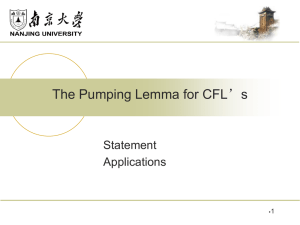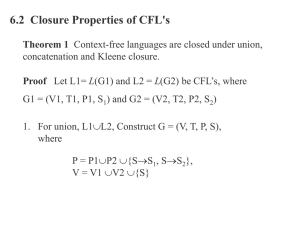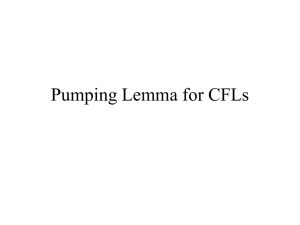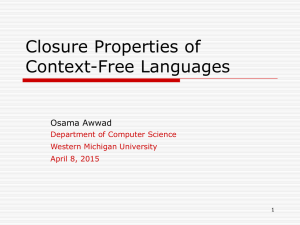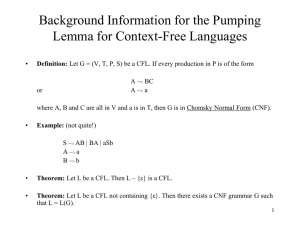PPT - The Stanford University InfoLab
advertisement
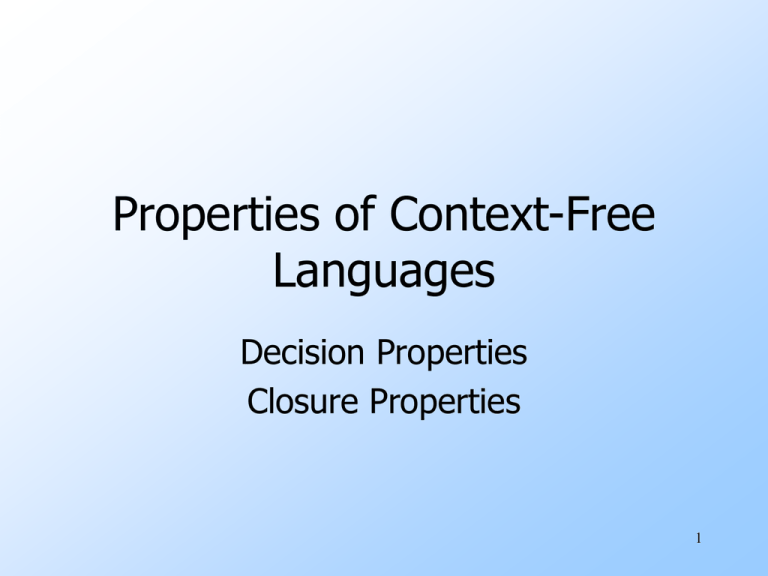
Properties of Context-Free
Languages
Decision Properties
Closure Properties
1
Summary of Decision Properties
As usual, when we talk about “a CFL”
we really mean “a representation for
the CFL, e.g., a CFG or a PDA
accepting by final state or empty stack.
There are algorithms to decide if:
1. String w is in CFL L.
2. CFL L is empty.
3. CFL L is infinite.
2
Non-Decision Properties
Many questions that can be decided for
regular sets cannot be decided for CFL’s.
Example: Are two CFL’s the same?
Example: Are two CFL’s disjoint?
How would you do that for regular languages?
Need theory of Turing machines and
decidability to prove no algorithm exists.
3
Testing Emptiness
We already did this.
We learned to eliminate variables that
generate no terminal string.
If the start symbol is one of these, then
the CFL is empty; otherwise not.
4
Testing Membership
Want to know if string w is in L(G).
Assume G is in CNF.
Or convert the given grammar to CNF.
w = ε is a special case, solved by testing if
the start symbol is nullable.
Algorithm (CYK ) is a good example of
dynamic programming and runs in time
O(n3), where n = |w|.
5
CYK Algorithm
Let w = a1…an.
We construct an n-by-n triangular array
of sets of variables.
Xij = {variables A | A =>* ai…aj}.
Induction on j–i+1.
The length of the derived string.
Finally, ask if S is in X1n.
6
CYK Algorithm – (2)
Basis: Xii = {A | A -> ai is a
production}.
Induction: Xij = {A | there is a
production A -> BC and an integer k,
with i < k < j, such that B is in Xik and
C is in Xk+1,j.
7
Example: CYK Algorithm
Grammar: S -> AB, A -> BC | a, B -> AC | b, C -> a | b
String w = ababa
X12={B,S}
X23={A}
X34={B,S}
X45={A}
X11={A,C}
X22={B,C}
X33={A,C}
X44={B,C}
X55={A,C}
8
Example: CYK Algorithm
Grammar: S -> AB, A -> BC | a, B -> AC | b, C -> a | b
String w = ababa
X13={}
Yields nothing
X12={B,S}
X23={A}
X34={B,S}
X45={A}
X11={A,C}
X22={B,C}
X33={A,C}
X44={B,C}
X55={A,C}
9
Example: CYK Algorithm
Grammar: S -> AB, A -> BC | a, B -> AC | b, C -> a | b
String w = ababa
X13={A}
X24={B,S}
X35={A}
X12={B,S}
X23={A}
X34={B,S}
X45={A}
X11={A,C}
X22={B,C}
X33={A,C}
X44={B,C}
X55={A,C}
10
Example: CYK Algorithm
Grammar: S -> AB, A -> BC | a, B -> AC | b, C -> a | b
String w = ababa
X14={B,S}
X13={A}
X24={B,S}
X35={A}
X12={B,S}
X23={A}
X34={B,S}
X45={A}
X11={A,C}
X22={B,C}
X33={A,C}
X44={B,C}
X55={A,C}
11
Example: CYK Algorithm
Grammar: S -> AB, A -> BC | a, B -> AC | b, C -> a | b
String w = ababa
X15={A}
X14={B,S}
X25={A}
X13={A}
X24={B,S}
X35={A}
X12={B,S}
X23={A}
X34={B,S}
X45={A}
X11={A,C}
X22={B,C}
X33={A,C}
X44={B,C}
X55={A,C}
12
Testing Infiniteness
The idea is essentially the same as for
regular languages.
Use the pumping lemma constant n.
If there is a string in the language of
length between n and 2n-1, then the
language is infinite; otherwise not.
Let’s work this out in class.
13
Closure Properties of CFL’s
CFL’s are closed under union,
concatenation, and Kleene closure.
Also, under reversal, homomorphisms
and inverse homomorphisms.
But not under intersection or
difference.
14
Closure of CFL’s Under Union
Let L and M be CFL’s with grammars G
and H, respectively.
Assume G and H have no variables in
common.
Names of variables do not affect the
language.
Let S1 and S2 be the start symbols of G
and H.
15
Closure Under Union – (2)
Form a new grammar for L M by
combining all the symbols and
productions of G and H.
Then, add a new start symbol S.
Add productions S -> S1 | S2.
16
Closure Under Union – (3)
In the new grammar, all derivations
start with S.
The first step replaces S by either S1 or
S2.
In the first case, the result must be a
string in L(G) = L, and in the second
case a string in L(H) = M.
17
Closure of CFL’s Under
Concatenation
Let L and M be CFL’s with grammars G
and H, respectively.
Assume G and H have no variables in
common.
Let S1 and S2 be the start symbols of G
and H.
18
Closure Under Concatenation – (2)
Form a new grammar for LM by starting
with all symbols and productions of G
and H.
Add a new start symbol S.
Add production S -> S1S2.
Every derivation from S results in a
string in L followed by one in M.
19
Closure Under Star
Let L have grammar G, with start symbol S1.
Form a new grammar for L* by introducing
to G a new start symbol S and the
productions S -> S1S | ε.
A rightmost derivation from S generates a
sequence of zero or more S1’s, each of which
generates some string in L.
20
Closure of CFL’s Under
Reversal
If L is a CFL with grammar G, form a
grammar for LR by reversing the right
side of every production.
Example: Let G have S -> 0S1 | 01.
The reversal of L(G) has grammar
S -> 1S0 | 10.
21
Closure of CFL’s Under
Homomorphism
Let L be a CFL with grammar G.
Let h be a homomorphism on the
terminal symbols of G.
Construct a grammar for h(L) by
replacing each terminal symbol a by
h(a).
22
Example: Closure Under
Homomorphism
G has productions S -> 0S1 | 01.
h is defined by h(0) = ab, h(1) = ε.
h(L(G)) has the grammar with
productions S -> abS | ab.
23
Closure of CFL’s Under Inverse
Homomorphism
Here, grammars don’t help us.
But a PDA construction serves nicely.
Intuition: Let L = L(P) for some PDA P.
Construct PDA P’ to accept h-1(L).
P’ simulates P, but keeps, as one
component of a two-component state a
buffer that holds the result of applying
h to one input symbol.
24
Architecture of P’
Input: 0 0 1 1
h(0)
Buffer
State of P
Read first remaining
symbol in buffer as
if it were input to P.
Stack
of P
25
Formal Construction of P’
States are pairs [q, b], where:
1. q is a state of P.
2. b is a suffix of h(a) for some symbol a.
Thus, only a finite number of possible values
for b.
Stack symbols of P’ are those of P.
Start state of P’ is [q0 ,ε].
26
Construction of P’ – (2)
Input symbols of P’ are the symbols to
which h applies.
Final states of P’ are the states [q, ε]
such that q is a final state of P.
27
Transitions of P’
1. δ’([q, ε], a, X) = {([q, h(a)], X)} for
any input symbol a of P’ and any stack
symbol X.
When the buffer is empty, P’ can reload it.
2. δ’([q, bw], ε, X) contains ([p, w], ) if
δ(q, b, X) contains (p, ), where b is
either an input symbol of P or ε.
Simulate P from the buffer.
28
Proving Correctness of P’
We need to show that L(P’) = h-1(L(P)).
Key argument: P’ makes the transition
([q0, ε], w, Z0)⊦*([q, x], ε, )
if and only if P makes transition
(q0, y, Z0) ⊦*(q, ε, ), h(w) = yx, and x
is a suffix of the last symbol of w.
Proof in both directions is an induction
on the number of moves made.
29
Nonclosure Under Intersection
Unlike the regular languages, the class
of CFL’s is not closed under .
We know that L1 = {0n1n2n | n > 1} is
not a CFL (use the pumping lemma).
However, L2 = {0n1n2i | n > 1, i > 1} is.
CFG: S -> AB, A -> 0A1 | 01, B -> 2B | 2.
So is L3 = {0i1n2n | n > 1, i > 1}.
But L1 = L2 L3.
30
Nonclosure Under Difference
We can prove something more general:
Any class of languages that is closed under
difference is closed under intersection.
Proof: L M = L – (L – M).
Thus, if CFL’s were closed under
difference, they would be closed under
intersection, but they are not.
31
Intersection with a Regular
Language
Intersection of two CFL’s need not be
context free.
But the intersection of a CFL with a
regular language is always a CFL.
Proof involves running a DFA in parallel
with a PDA, and noting that the
combination is a PDA.
PDA’s accept by final state.
32
DFA and PDA in Parallel
DFA
Input
PDA
S
t
a
c
k
Accept
if both
accept
Looks like the
state of one PDA
33
Formal Construction
Let the DFA A have transition function δA.
Let the PDA P have transition function δP.
States of combined PDA are [q,p], where
q is a state of A and p a state of P.
δ([q,p], a, X) contains ([δA(q,a),r], ) if
δP(p, a, X) contains (r, ).
Note a could be , in which case δA(q,a) = q.
34
Formal Construction – (2)
Accepting states of combined PDA are
those [q,p] such that q is an accepting
state of A and p is an accepting state of
P.
Easy induction: ([q0,p0], w, Z0)⊦*
([q,p], , ) if and only if δA(q0,w) = q
and in P: (p0, w, Z0)⊦*(p, , ).
35
